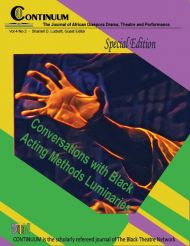Shakespeare In & Out of Africa. Edited by Jane Plastow. African Theatre 12. Woodbridge, Suffolk, UK: James Currey, 2013; 208 pp. $34.95 paper.
The African Theatre series is an excellent resource for scholars and artists seeking information on African performance traditions and theatrical practice, and Shakespeare In & Out of Africa is a great addition to the series. The essays address issues central to postcolonialism and adaptation studies: questions of authority and language, cultural hegemony, national identity, and the commodification of global south culture. Most articles focus on performances at the 2012 Globe to Globe Festival, which brought theatre companies from thirty-seven countries to perform Shakespeare’s works in translation at the New Globe Theatre in London. In this context, representation, authority, and language were particularly fraught because of Shakespeare’s status as a globalized symbol of British (European/Western) identity and London’s position as both a post-imperial capital and neo-liberal power center. This volume analyzes the problems of representation for the performers from sub-Saharan African nations.
Shakespeare In & Out of Africa takes an admirably broad approach, looking at performances from six different nations, and working through issues important to performance studies, postcolonialism, and adaptation studies. Femi Osofisan’s introduction contextualizes the Globe to Globe Festival and summarizes many of the authors’ overriding concerns. This is followed by four essays on specific Globe to Globe performances: Penelope Woods writes about The Two Gents’ Vacomana Vaviri Ve Zimbabwe, a Shona adaptation of Two Gentlemen of Verona; Colette Gordon describes the Isango Ensemble’s adaptation of the poem Venus and Adonis into Uvenas no Adonisi, incorporating six of South Africa’s official languages; Adesola Adeyemi studies Ìtàn Ògìnìntìn, a version of The Winter’s Tale in classical Yoruba; and Christine Matzke takes on Cymbeline, performed in Juba Arabic by the South Sudan Theatre Company. Shifting away from the specific focus on Globe to Globe performances, Michael Walling interviews several theatre practitioners and adapters from various nations, and two essays analyze creole adaptations and attempts to legitimize creole languages in Mauritius and the Cape Verde Islands. The collection wraps up with the play script of Osofisan’s Wèsóo, Hamlet!
Despite the varied subjects, these essays share several common concerns, for instance, the tension between exoticizing national cultures for London audiences on the one hand, and promoting a national identity through adapting and performing Shakespeare on the other. Osofisan describes “the decision by almost all the companies to play up the exotic elements in their productions, a choice that won them uproarious reactions in London, but which was invariably criticized by some of their more discerning countrymen in the audience” (7). Gordon and Adeyemi address variations on this problem encountered by the South African and Nigerian companies. As Adeyemi explains, the Nigerians struggled to find actors to perform in classical Yoruba, and ended up sacrificing quality for linguistic conservatism. The adaptation, which incorporated Igunnuko masked performance, met with mixed reactions from Nigerians in the audience. While they were happy to see Igunnuko and hear Yoruba spoken on stage, some “thought that its performance was flawed by poor manipulation of the form” (56). The Isango Ensemble’s Uvenas no Adonisi developed a fraught relationship to township culture, which for many reviewers became the source of authority for Isango’s ‘authenticity’ as black South African performers. This association necessarily distorted and simplified the township as a cultural space, limiting and exoticizing how London audiences perceived the show (Gordon 40).
On the other hand, adapting Shakespeare can help provide legitimacy for emerging nations or repressed languages. This becomes most apparent in the unifying aspirations of the South Sudan Theatre Company—the first theatrical production from the new nation. The SSTC drew its membership from many of South Sudan’s cultural and ethnic groups, combining numerous performance heritages into a conglomerate Cymbeline promoting a message of national unity (Matzke 71). The legitimizing power of Shakespearean theatre is also apparent in the essays on creole performance, which describe efforts to establish Mauritian Kreol and Cape Verdean Crioulo as legitimate and poetic languages. Eunice Ferreira explains the intersections of language, culture, and identity: “Theatre in the islands reflects interplay along a Crioulo spectrum with Europe on one end and Africa on the other. The post-independence theatre movement in Cape Verde and the theatrical tensions manifested on and off stage continually raise questions of what it means to be Crioulo – racially, culturally, nationally, and internationally” (111).
Osofisan’s play, Wèsóo, Hamlet!, raises questions about colonialism and self-determination, particularly as the Hamlet plot tyrannically overshadows the Nigerian characters who struggle to avoid the seemingly inevitable events of Shakespeare’s tragedy. With characteristic postmodern playfulness, Osofisan brings Hamlet, Ophelia, and Claudius out of the afterlife to try and alter the tragedy replaying in Yorubaland. Shakespeare’s characters interact with their Nigerian avatars—Létò, Túndùn, and Ọba Ayíbĩ—but the plot finally unfolds as it did in Denmark. This adaptation parallels the economic exploitation of African communities with the influence of the Shakespearean source text on the events of Osofisan’s plot. The parallel exposes limitations imposed on Africa—culturally, economically, and politically—by the global north and its local representatives.
The tensions explored in this collection—over language, representation, culture, and power—are problems central to postcolonial theory and adaptation studies. In taking on the context of the Globe to Globe Festival, these essays develop complex readings of the limits and possibilities for intercultural theatre to promote cosmopolitan awareness and enact political liberation. Particularly in conjunction with videos of the performances (available at https://globeplayer.tv/globe-to-globe), these essays will be of great use to postcolonialists, theatre and performance scholars, and adaptation studies scholars. Though the specific focus in most of the essays may limit the use of this collection as a central text in classrooms, these essays, especially with the production videos, may be of interest in courses like intercultural performance, Shakespearean adaptation, or arts administration. These essays may also be a helpful resource for performative dissertation/thesis work situated in a transnational sub-Saharan African scope.
Shakespeare In & Out of Africa does an excellent job focusing on a culturally significant festival and drawing out from it a variety of tensions that continue to shape African national identities, theatre, and the dynamics of power and culture on a global scale.
Phillip Zapkin
West Virginia University


